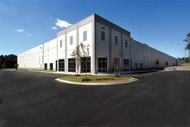|
SOUTHEAST SNAPSHOT, JULY 2012
BALTIMORE INDUSTRIAL MARKET
 |
Thomas |
|
Industrial real estate is tied to levels of economic activity, and the Baltimore industrial real estate market continues to benefit from the general economic recovery. The need for industrial space is growing as businesses seek properties to accommodate increasing demand from their customers. Because of this increased activity, Baltimore saw positive net industrial absorption in 2011 for the second consecutive year. In the first quarter of this year, approximately 900,000 square feet of industrial space was absorbed. With an overall vacancy rate of just under 11 percent for the 153 million-square-foot market, the supply and demand balance is moving towards equilibrium, where landlords and tenants are on similar footing in negotiations.
As the market moves towards equilibrium and rents rebound, developers have begun to assess and pursue potential new opportunities. In the Baltimore-Washington Corridor, we’ve seen very little new construction during the last two years. However, developers are currently readying a few sites for potential bulk warehouse product. With more than 8 million people in the Baltimore/D.C. metro market, as well as access to the Port of Baltimore and America’s number one consumer — the U.S. Government — this location is optimal for a range of companies serving their customer bases.
 |
This modern 300,000-square-foot industrial development by First Industrial at 1225 Bengies Road in the Baltimore East market achieved full occupancy in 2011. |
|
With regard to future development, the Baltimore industrial story is the same as as it was prior to the Great Recession: quality sites are scarce, which helps keep a cap on new supply. Also, redevelopment opportunities are not easy to find. Similar to many markets across the country, new deliveries have been few and far between. With demand impacted by the recession, rental rates were under pressure so developers had little incentive to build even if they had access to capital, which was also limited. To execute new buildings, the market is seeing some assemblages occurring. Another opportunity for new activity will be from redevelopment of existing properties as developers navigate changes to comply with new storm water management regulations.
As an attractive and very liquid industrial investment market, Baltimore should see both speculative and build-to-suit development in the near future. The availability rate for Class A bulk industrial space is significantly lower than the overall market, so companies that require cross-docking, higher ceiling heights and large truck courts have fewer choices. The “sweet spot” for new buildings will continue to be in the 100,000- to 300,000-square-foot range.
As an alternative to the Interstate 81 Corridor in Pennsylvania and the Interstate 95 Corridor in New Jersey, Baltimore’s Interstate 95 North market is attractive to large corporate users due to its proximity to the Port of Baltimore and the fact that nearly 40 percent of the U.S. population is within a day’s truck drive. A number of well-known consumer goods, retailers and other businesses call the area home.
Currently, there is a 692,000-square-foot new development in process in Harford County that could accommodate a large user in the market. However, beyond that, new development would be required to meet incremental demand.
Also noteworthy is that the Port of Baltimore is growing in importance as a driver of demand for industrial space. Tonnage grew 15 percent last year, making Baltimore the fastest growing port in the U.S. in 2011. The Port ranks first in the U.S. for automobiles and roll-on/roll-off cargo. The Port of Baltimore is also positioned for growth as planners have dredged a deeper channel and are adding four cranes to handle cargo from larger ships in anticipation of the expanded Panama Canal opening in 2014.
A potential driver of future industrial activity and economic growth for the region is an intermodal facility for the CSX rail line. The new intermodal facility could help the region capture some of the increased traffic emanating from the widening of the Panama Canal. The location has not been announced, but the state has a short list of four sites between Baltimore and Washington, with construction on the intermodal facility slated for 2013 and a targeted operational date of 2015. While the overall market should reap the benefits of increased activity associated with the facility, proximate sites would become more attractive.
The Baltimore industrial market’s attractiveness is not limited to companies seeking locations for their operations. Properties in this market remain a strong investment choice, with the overall cap rate already in the low 6s and trending lower. For Class A properties with a lease to an investment-grade tenant, cap rates can dip into the 5s.
With its large proximate population and transportation network including the Port of Baltimore, the Baltimore industrial market will continue to offer opportunities for users and investors alike. With quality in-fill land sites tough to come by, new supply will continue to be constrained. Coupled with a potential boost from the planned intermodal facility and customers requiring Class A facilities, the Baltimore market could offer select opportunities for developers to build new or redevelop old facilities to meet demand.
— Jeff Thomas is senior regional director with First Industrial Realty Trust.
©2012 France Publications, Inc. Duplication
or reproduction of this article not permitted without authorization
from France Publications, Inc. For information on reprints
of this article contact Barbara
Sherer at (630) 554-6054.
|
